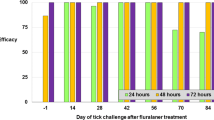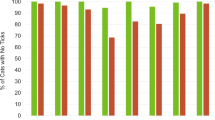Abstract
Cat fleas (Ctenocephalides felis) and the castor bean tick (Ixodes ricinus) cause discomfort and health effects due to bites and ingestion of blood and they serve as vectors for several animal and human pathogens. Effectiveness of a novel 10 % w/v fipronil spot-on (Eliminall®/Exproline vet™, marketed by Pfizer Animal Health and registered and manufactured by Krka, d.d., Novo mesto) was confirmed against these parasites on experimentally infested cats. Two parallel, unicentre and masked controlled studies were conducted with European mixed breed and mixed sex cats. Cats were allocated randomly to one of two treatment groups based on either pre-treatment flea counts (study 1) or pre-treatment tick counts (study 2). In each of the study, eight animals served as control, while another eight animals were treated once topically with the unit label dose of 50 mg fipronil per cat (10.6–23.8 mg/kg). At each reinfestation, animals were infested with approximately 100 fleas or 60 ticks to achieve adequate infestation rates. Parasites were removed and counted on days 2, 9, 16, 23, 30 and 37, 48 h after the treatment or experimental infestation. Excellent effectiveness was demonstrated on day 2 (100 and 94 % efficacy against fleas and ticks, respectively) and lasted for up to 5 weeks (efficacy ≥96 %) against fleas and up to 4 weeks against ticks (efficacy ≥94 %). The product was well tolerated and no adverse reactions were observed.
Similar content being viewed by others
References
Berrada ZL, Telford SR 3rd (2009) Burden of tick-borne infections on American companion animals. Top Companion Anim Med 24:175–181
Beugnet F, Marié JL (2009) Emerging arthropod-borne diseases of companion animals in Europe. Vet Parasitol 163:298–305
Bonneau S, Fourier JJ, Rousseau C, Cadiergues MC (2010) Comparative efficacy of two fipronil spot-on formulations against experimental flea infestations (Ctenocephalides felis) in dogs. Int J Appl Res Vet Med 8:16–20
Cadiergues MC, Bonneau SG, Fourier JJ (2011) Assay of two 10% (w/v) fipronil spot-on formulations against feline infestations with Ctenocephalides felis. J Feline Med Surg 13:304–308
Cochet P, Birckel P, Bromet-Petit M, Bromet N, Weil A (1997) Skin distribution of fipronil by microautoradiography following topical administration to the beagle dog. Eur J Drug Metab Pharmacokinet 22:211–216
Dryden MW (2009) Flea and tick control in the 21st century: challenges and opportunities. Vet Dermatol 20:435–440
Franc M, Yao KP (2007) Comparison of the activity of selamectin, imidacloprid and fipronil for the treatment of cats infested experimentally with Ctenocephalides felis felis and Ctenocephalides felis strongylus. Vet Parasitol 143:131–133
Hovda LR, Hooser SB (2002) Toxicology of newer pesticides for use in dogs and cats. Vet Clin Small Anim 32:455–467
Hutchinson MJ, Jacobs DE, Fox MT, Jeannin P, Postal JM (1998) Evaluation of flea control strategies using fipronil on cats in a controlled simulated home environment. Vet Rec 142:356–357
Marchiondo AA, Holdsworth PA, Green P, Blagburn BL, Jacobs JP (2007) World Association for the Advancement of Veterinary Parasitology (W.A.A.V.P.) guidelines for evaluating the efficacy of parasiticides for the treatment, prevention and control of flea and tick infestation on dogs and cats. Vet Parasitol 145:332–344
Medleau L, Hnilica KA, Lower K, Alva R, Clekis T, Case J, McArthur TR, Barrick RA, Jeannin P, Irwin J (2002) Effect of topical application of fipronil in cats with flea allergic dermatitis. J Am Vet Med Assoc 221:254–257
Mehlhorn H, Hansen O, Mencke N (2001) Comparative study on the effects of three insecticides (fipronil, imidacloprid, selamectin) on developmental stages of the cat flea (Ctenocephalides felis Bouché 1835): a light and electron microscopic analysis of in vivo and in vitro experiments. Parasitol Res 87:198–207
Nau R, Christen HJ, Eiffert H (2009) Lyme disease—current state of knowledge. Dtsch Arztebl Int 106:72–81
Pollmeier M, Pengo G, Jeannin SM (2001) Evaluation of the efficacy of frontline (fipronil) and control of European castor bean tick (Ixodes ricinus) infestations in the dog and cat. Kleintierpraxis 46:99–104
Rust MK (2005) Advances in the control of Ctenocephalides felis (cat flea) on cats and dogs. Trends Parasitol 21:232–236
Acknowledgments
The authors gratefully acknowledge the contributions of the technical staff at ClinVet and Charles Rivers Laboratories in the conduct of these studies and the cooperative effort between Krka and Pfizer Animal Health in the commercialisation of this novel fipronil spot-on. The studies reported herein were sponsored and funded by Krka, d.d., Novo mesto, Šmarješka cesta 6, SI-8501, Novo mesto, Slovenia. Employees of the sponsor were involved in the study design, the analysis and interpretation of study data, the writing of the manuscript and the decision to submit the manuscript for publication. Employees of the sponsor were not directly involved in the collection and recording of study data.
Conflict of interest
Authors Jernej Kužner and Sandra Turk are current employees of Krka, d.d., Novo mesto and were involved in the study design, data analysis and preparation and review of the manuscript. Authors Alan A. Marchiondo and Douglas Rugg are current employees of Pfizer Animal Health, USA, and participated in the preparation and review of the manuscript. None of these authors were directly involved in the collection and recording of data. There were no conflicting interests that may have biased the work reported herein. Author Josephus J. Fourie is current employee of ClinVet International, South Africa, and was involved in the study design and collection and recording of the data within the limitations of the study and in preparation and review of the manuscript. Author Sarah Grace is current employee of Charles River Laboratories, Ireland, and was involved in the study design and collection and recording of the data within the limitations of the study and in preparation and review of the manuscript.
Author information
Authors and Affiliations
Corresponding author
Rights and permissions
About this article
Cite this article
Kužner, J., Turk, S., Fourie, J.J. et al. Efficacy of a novel fipronil spot-on for the treatment and control of induced infestations of adult cat fleas (Ctenocephalides felis) and castor bean ticks (Ixodes ricinus) on cats. Parasitol Res 112, 365–372 (2013). https://doi.org/10.1007/s00436-012-3144-y
Received:
Accepted:
Published:
Issue Date:
DOI: https://doi.org/10.1007/s00436-012-3144-y




